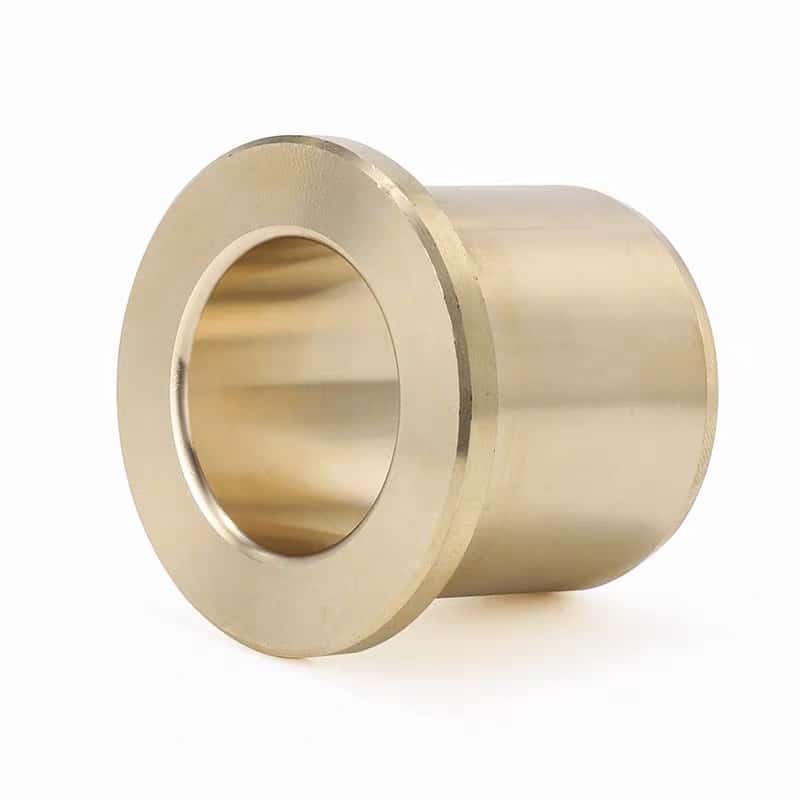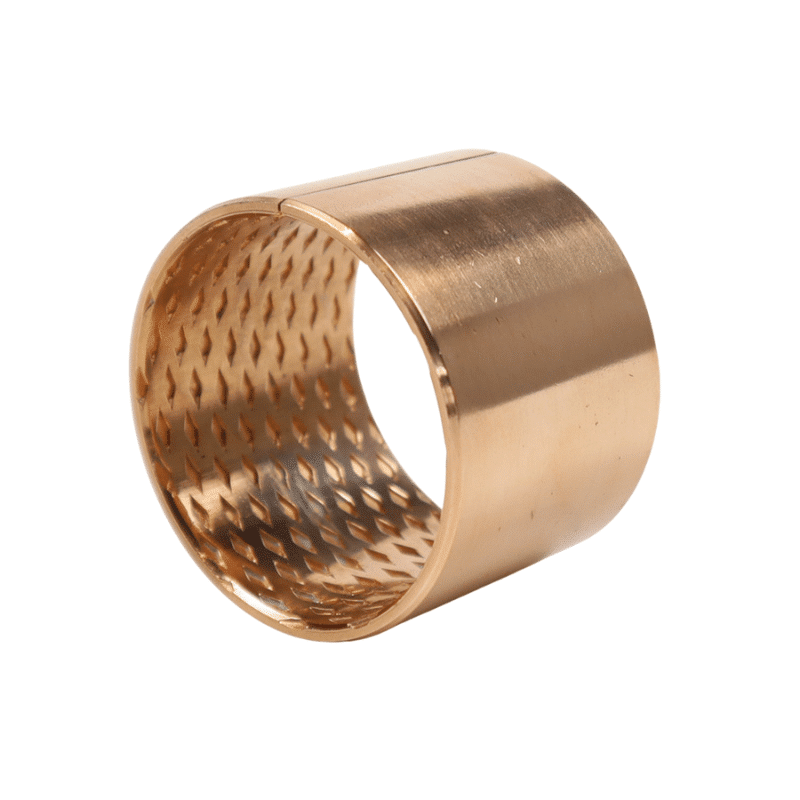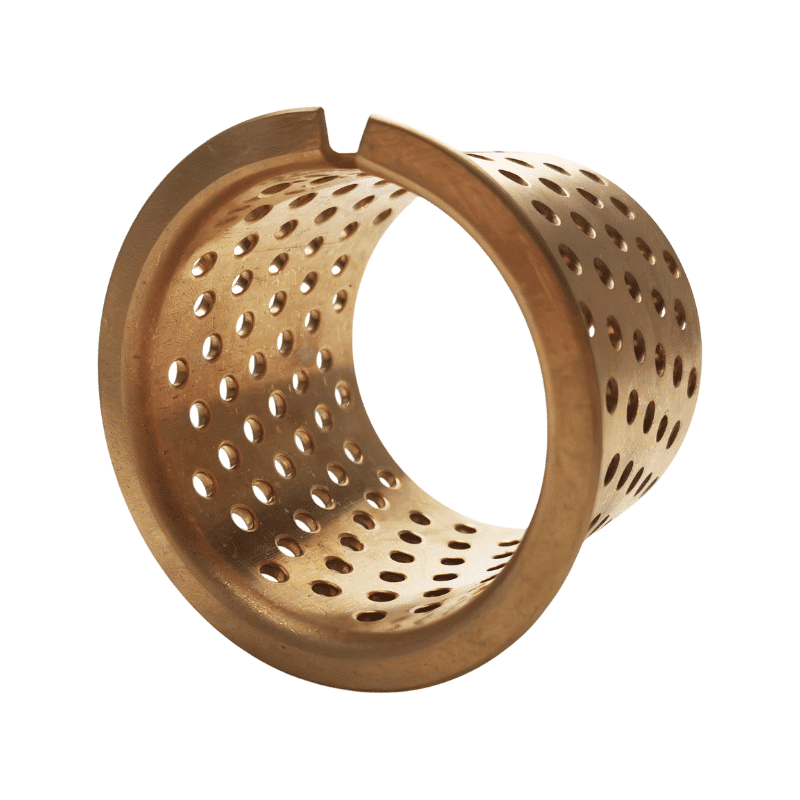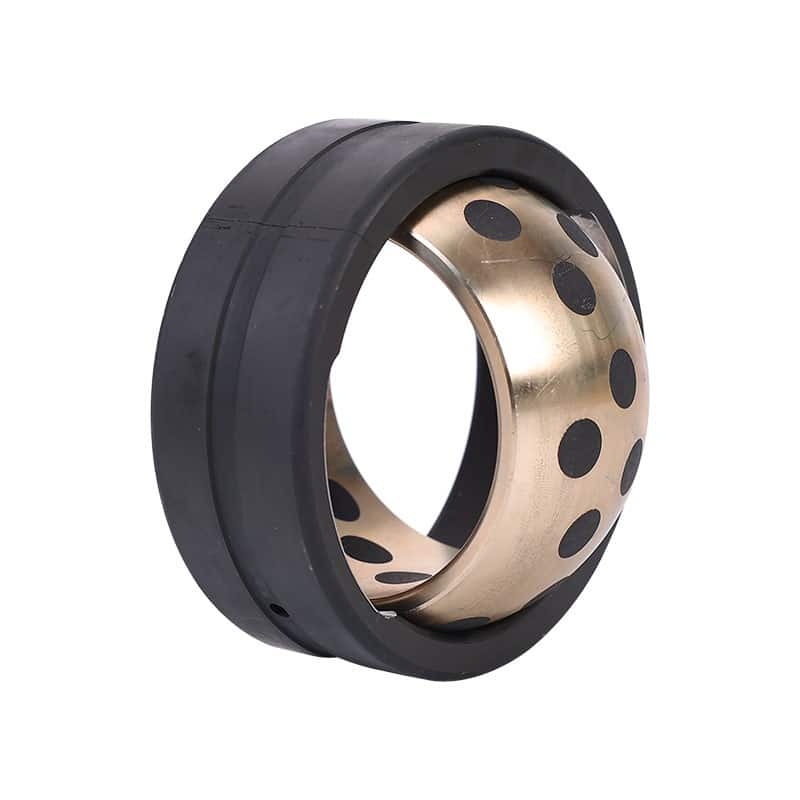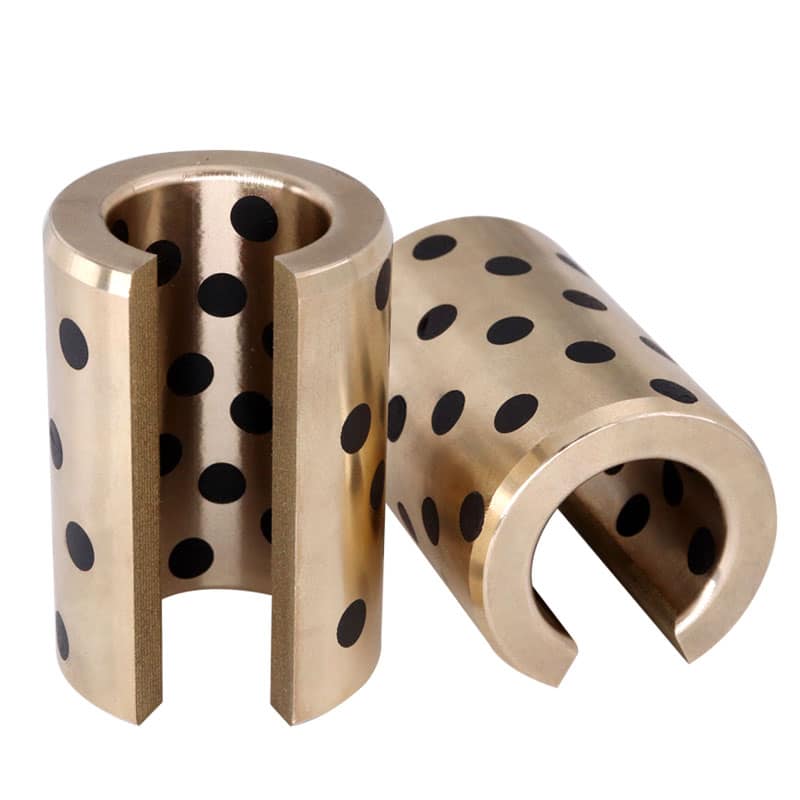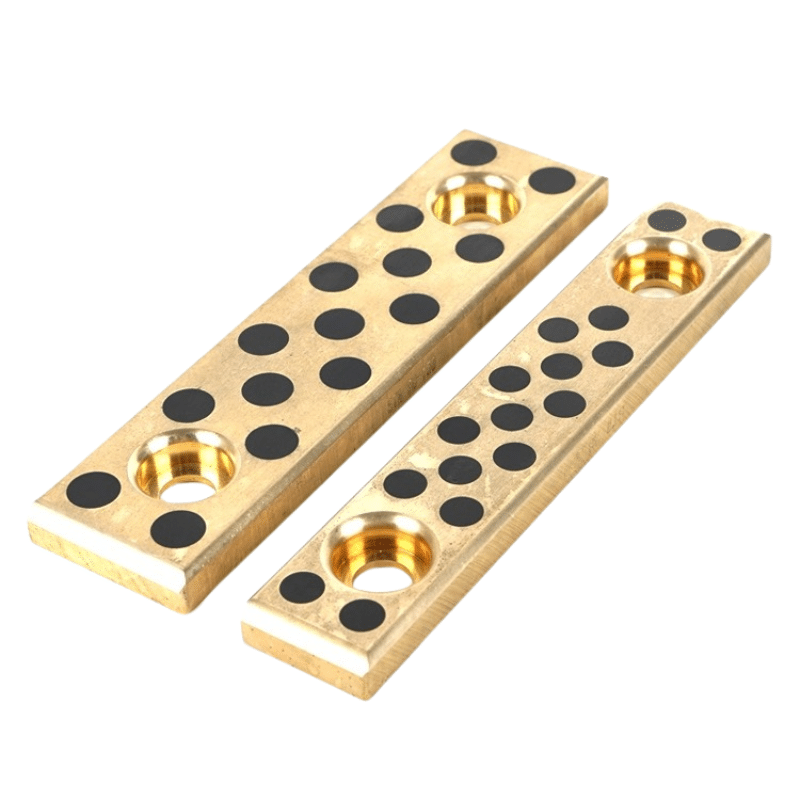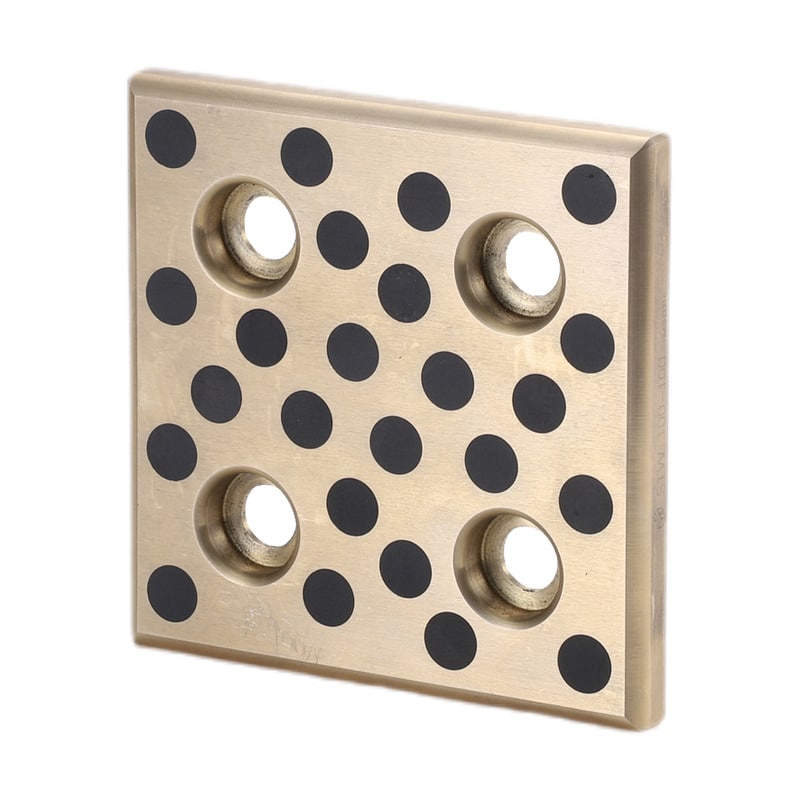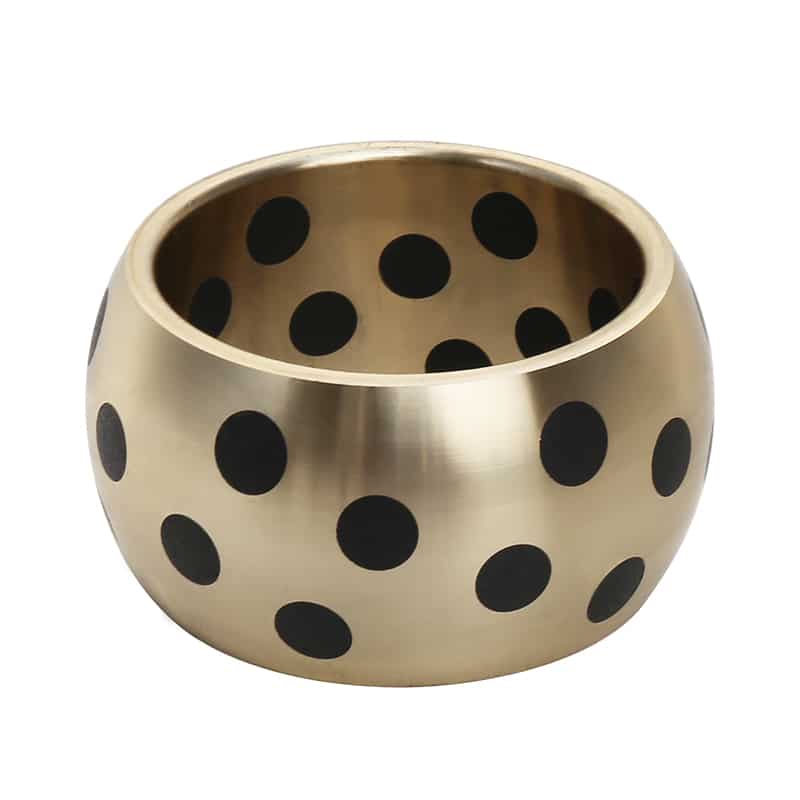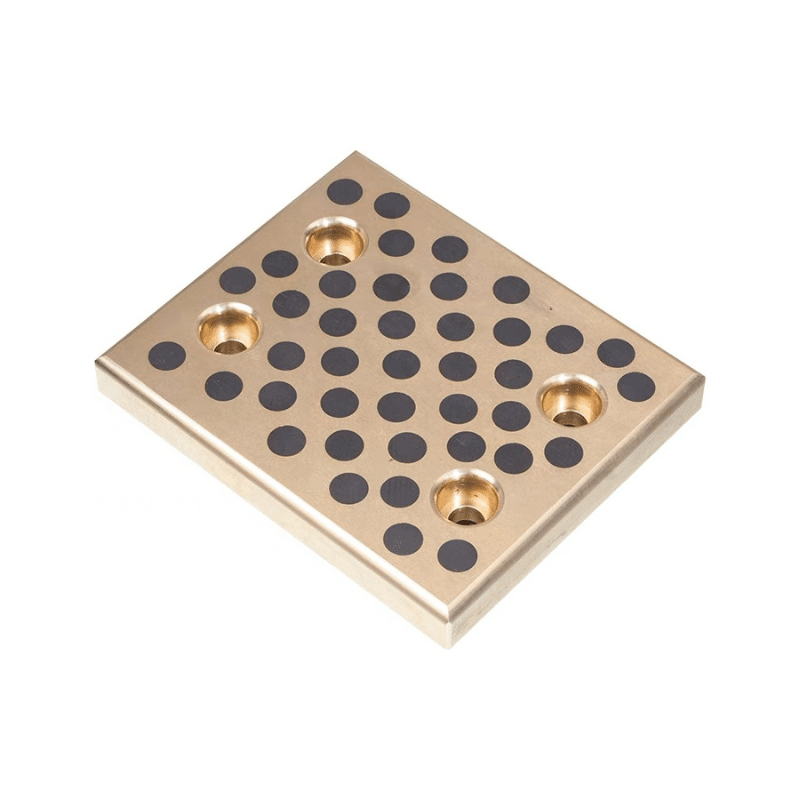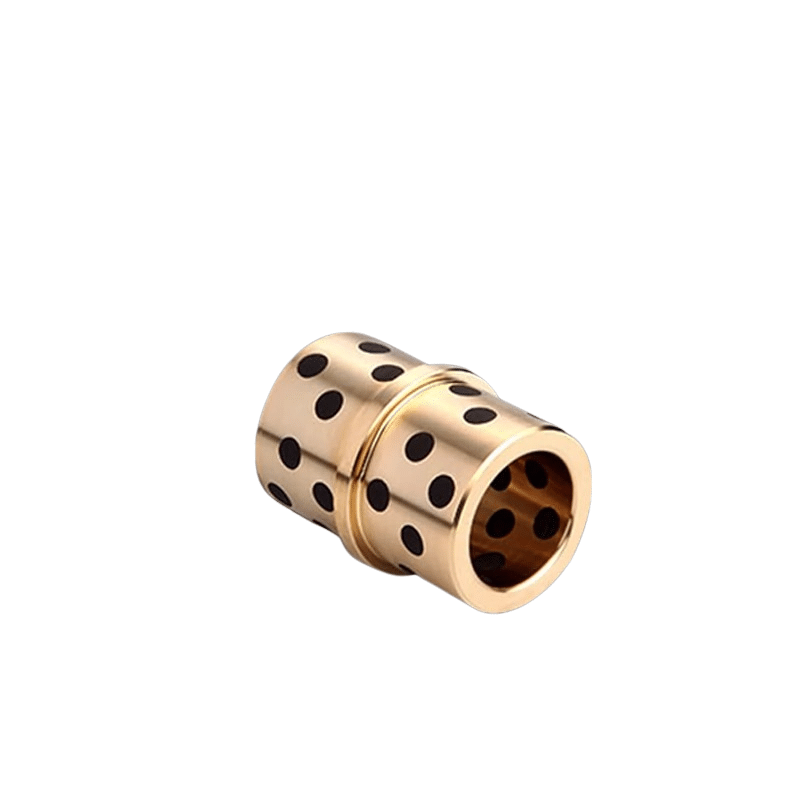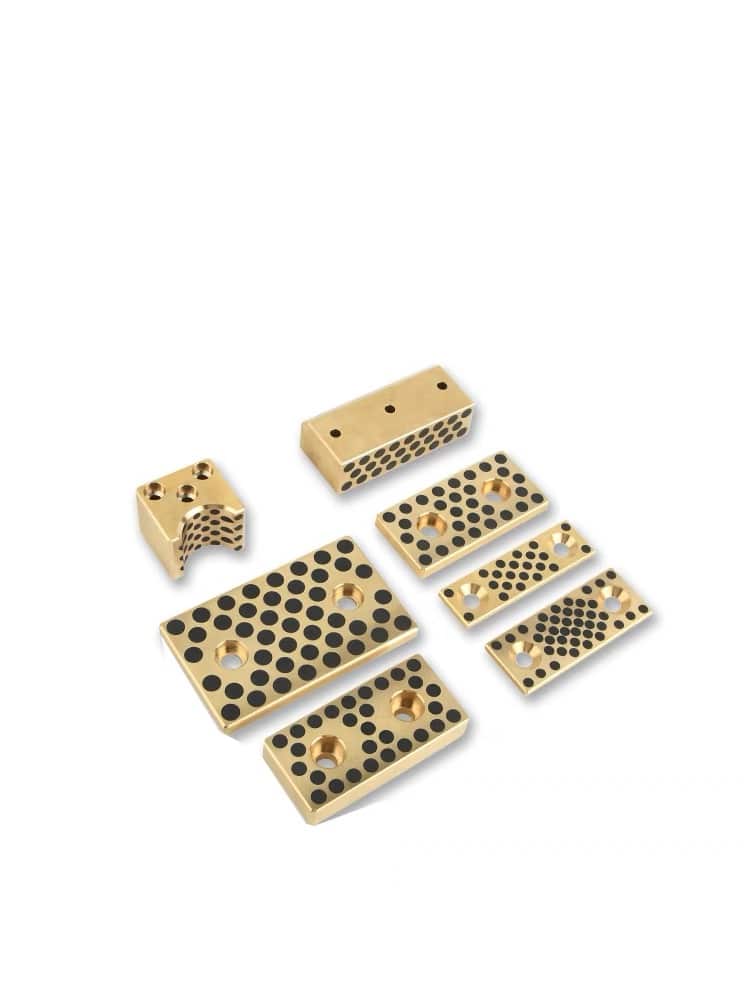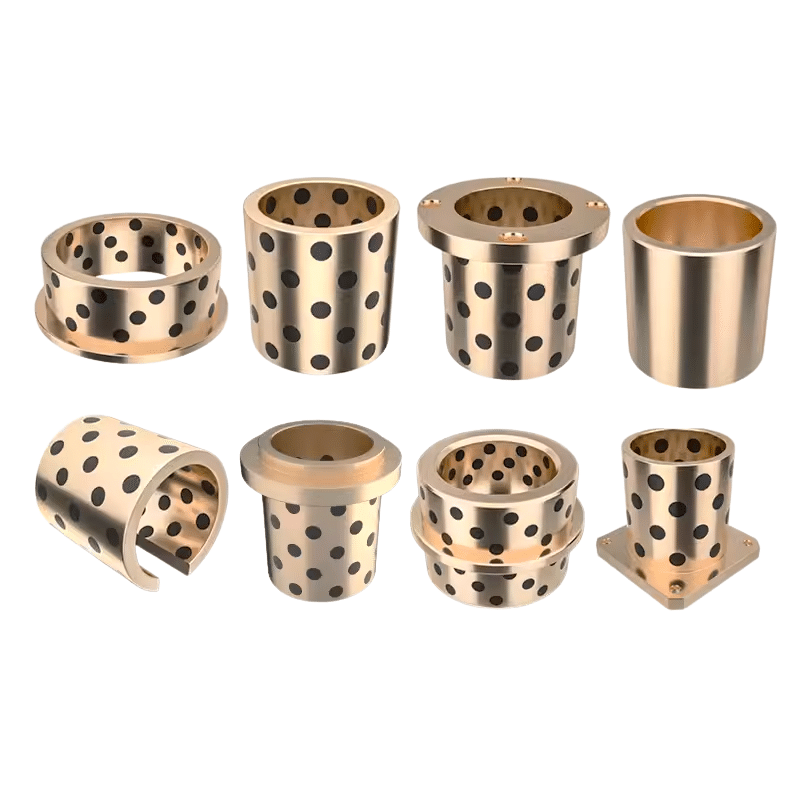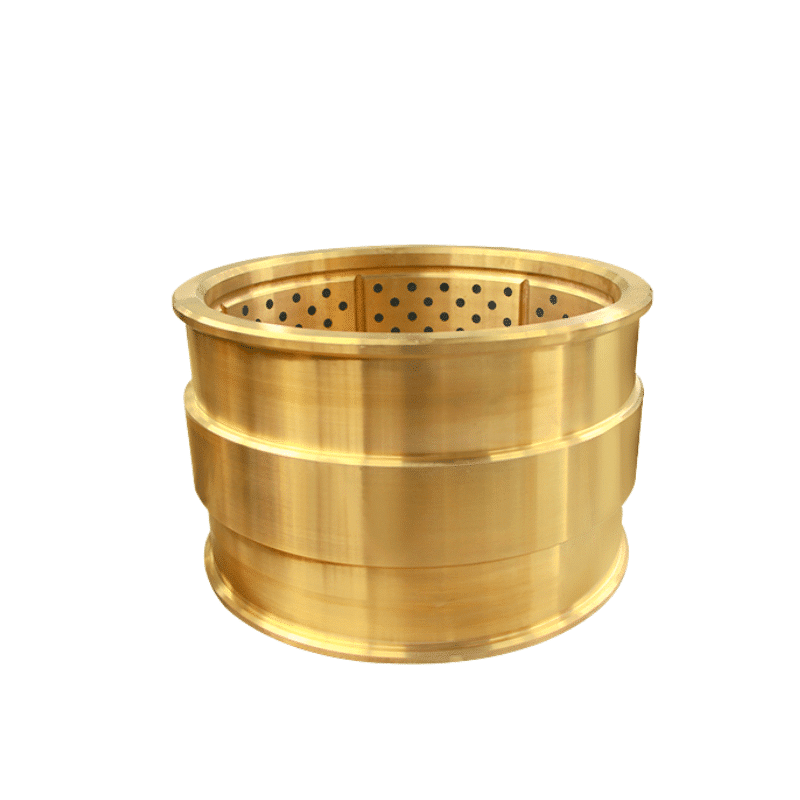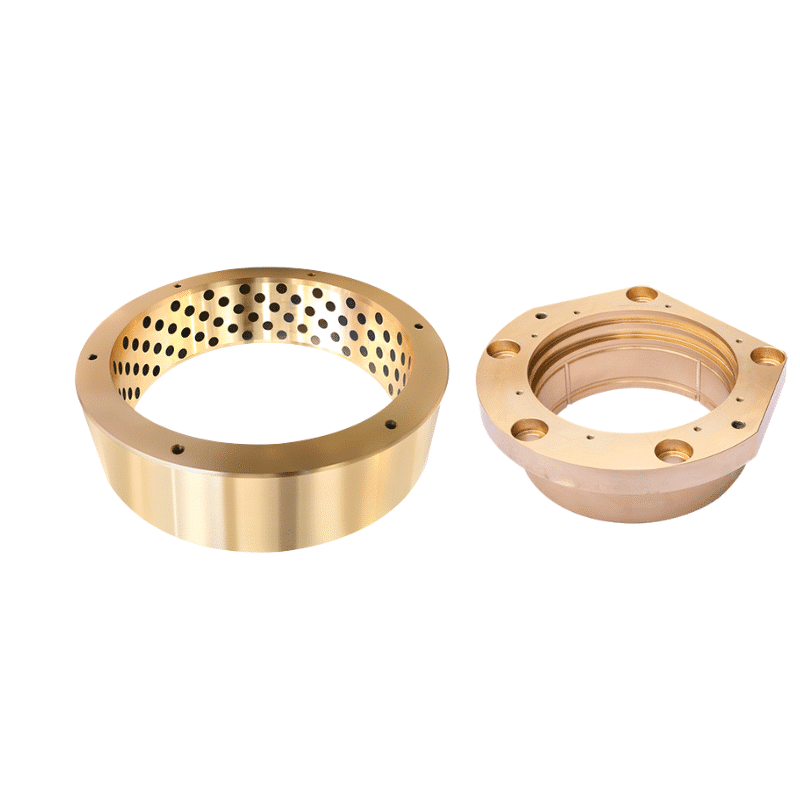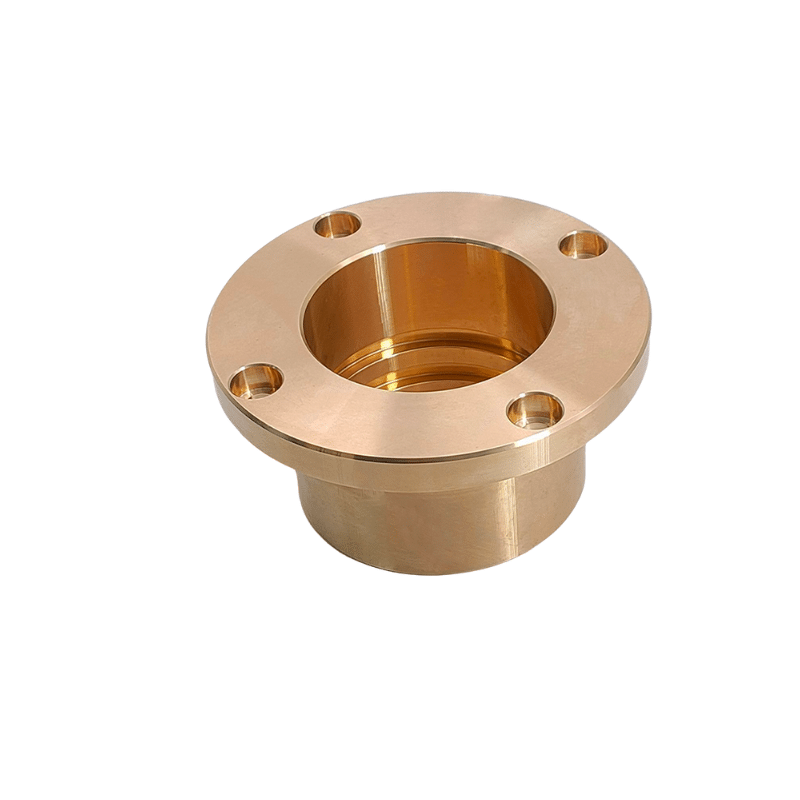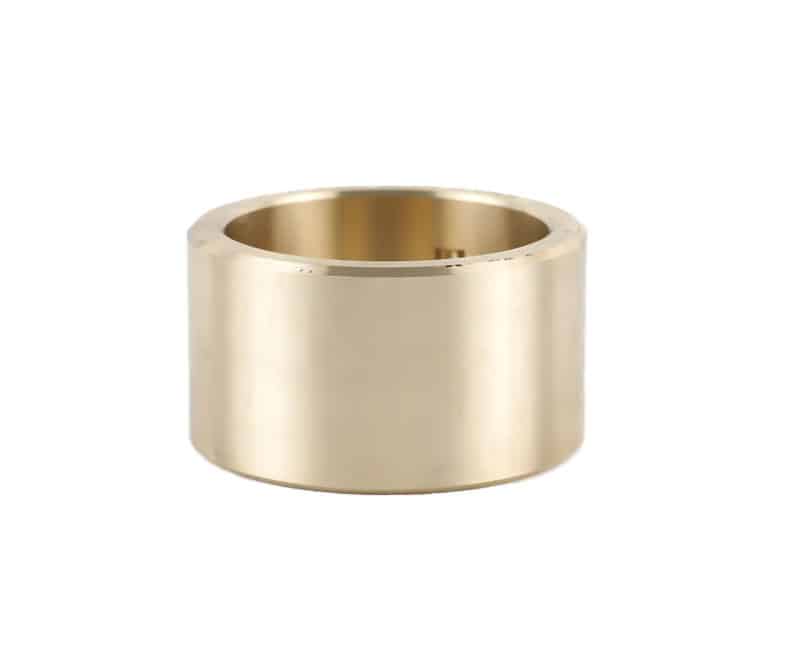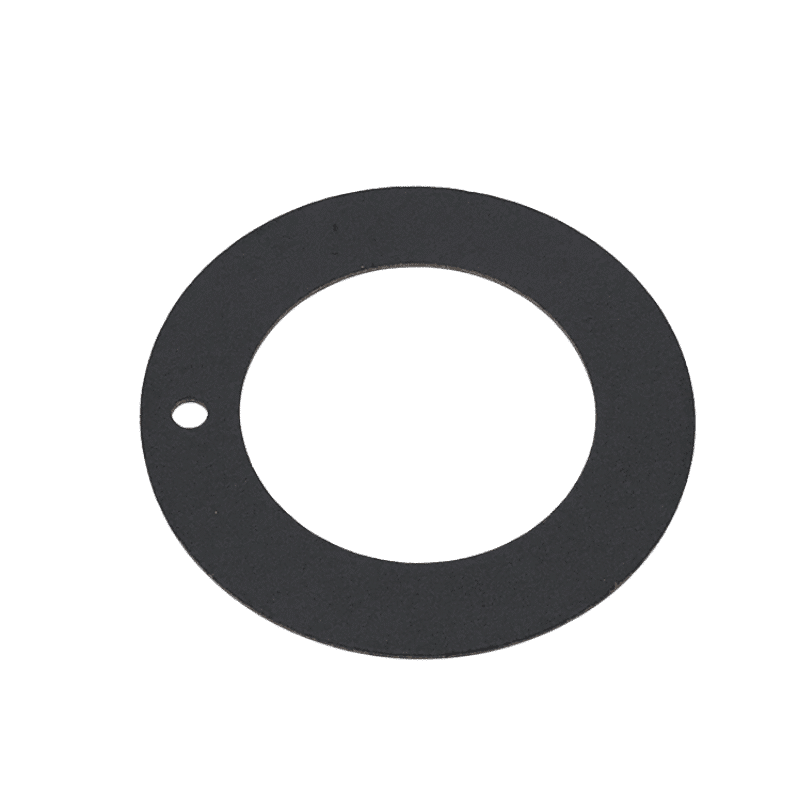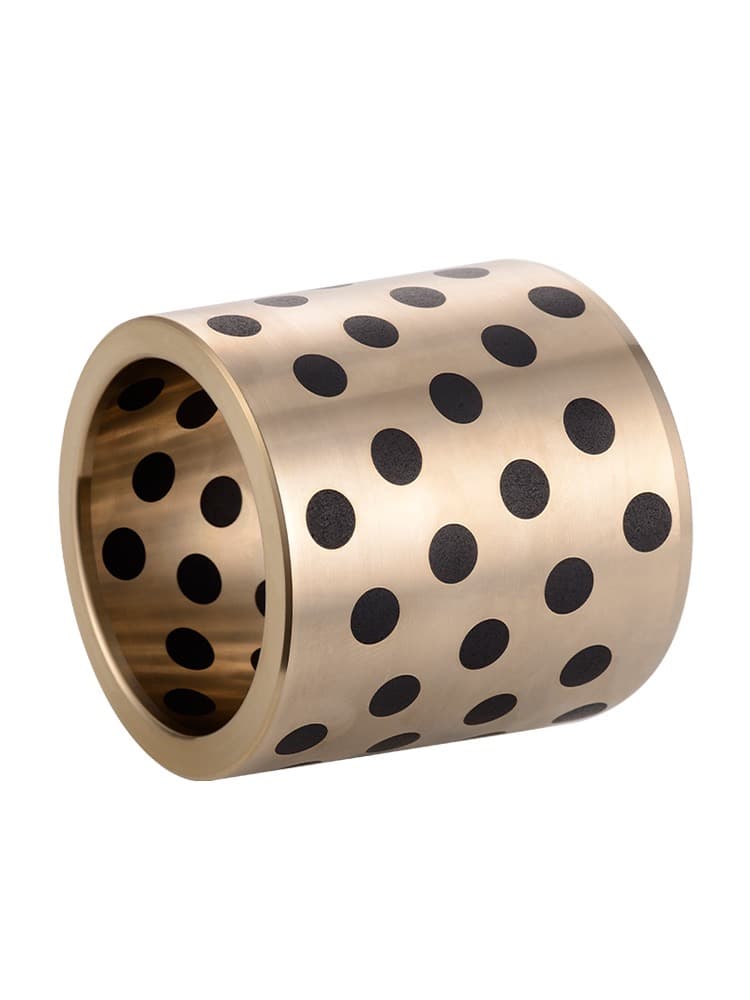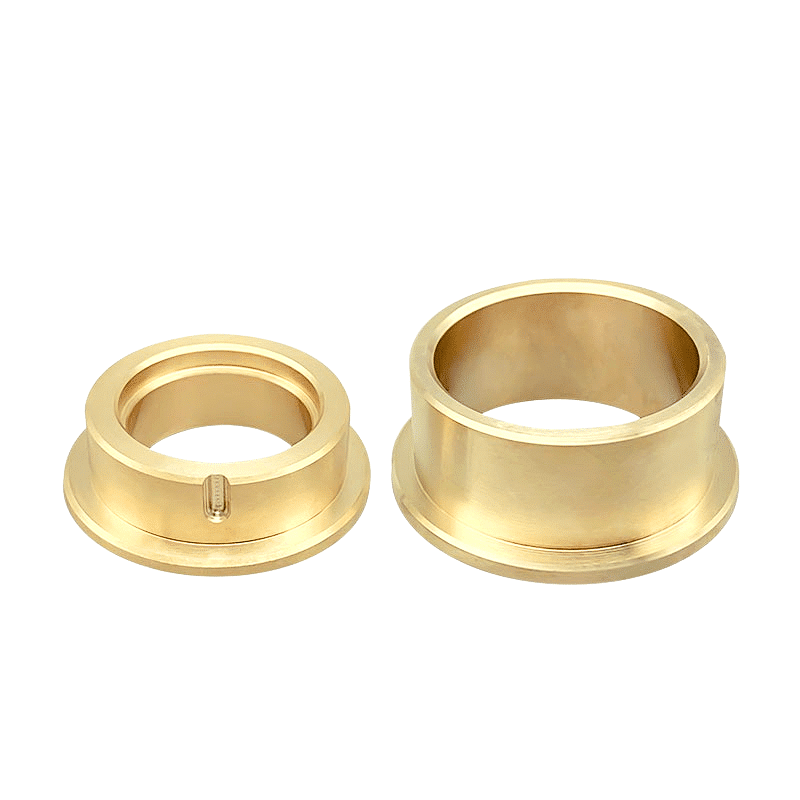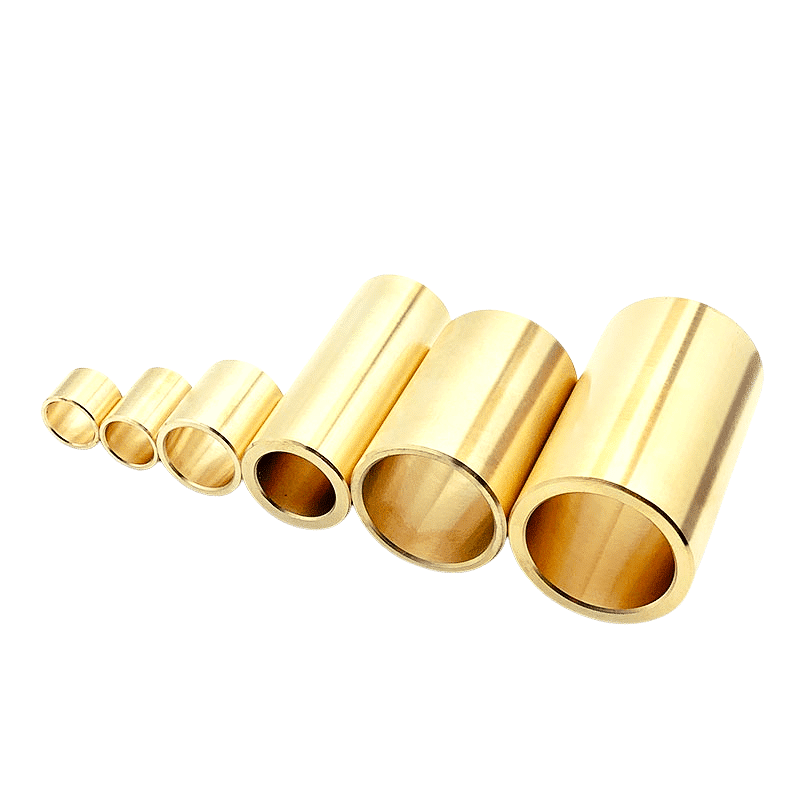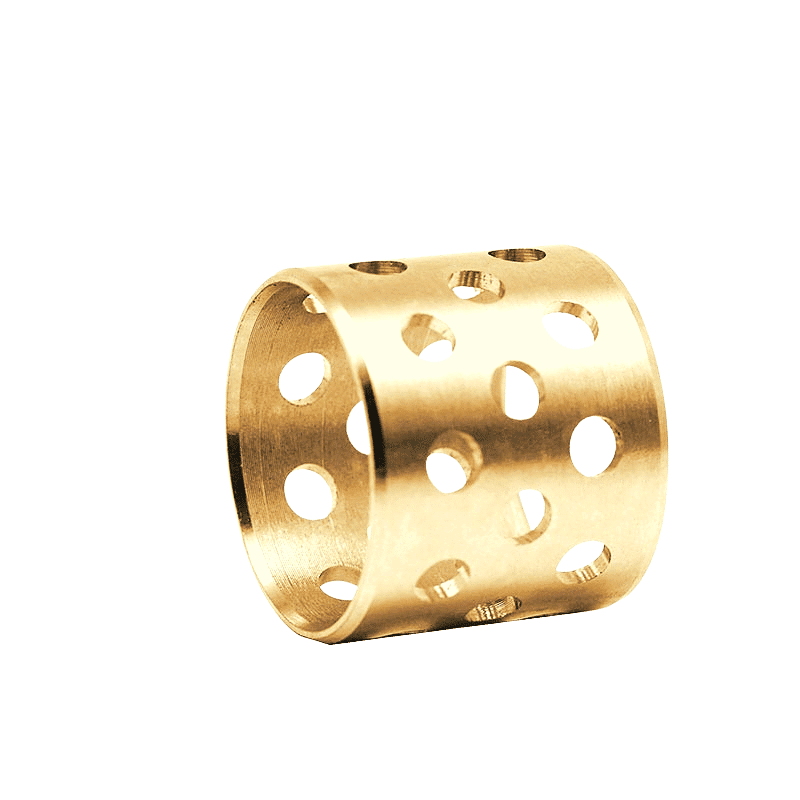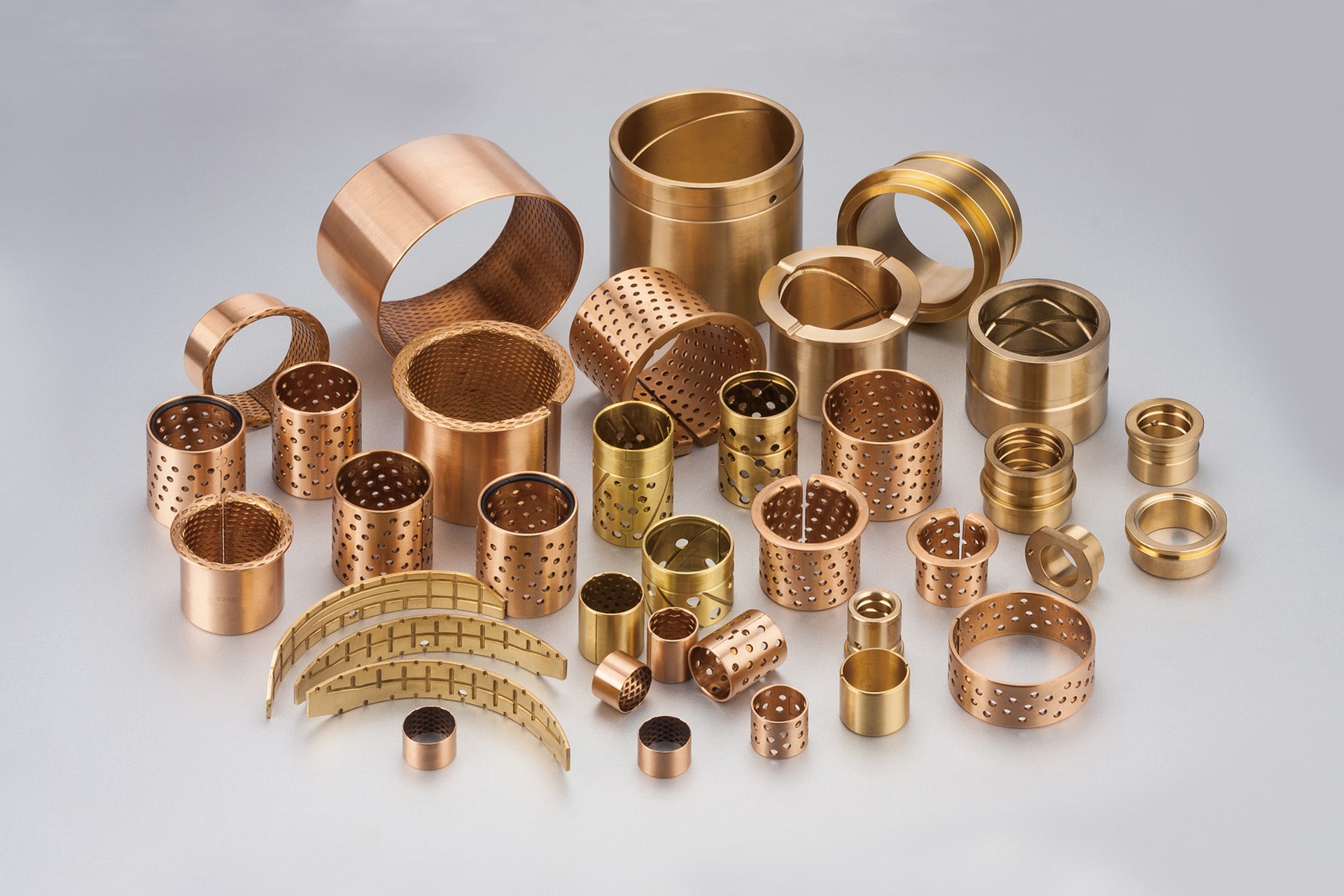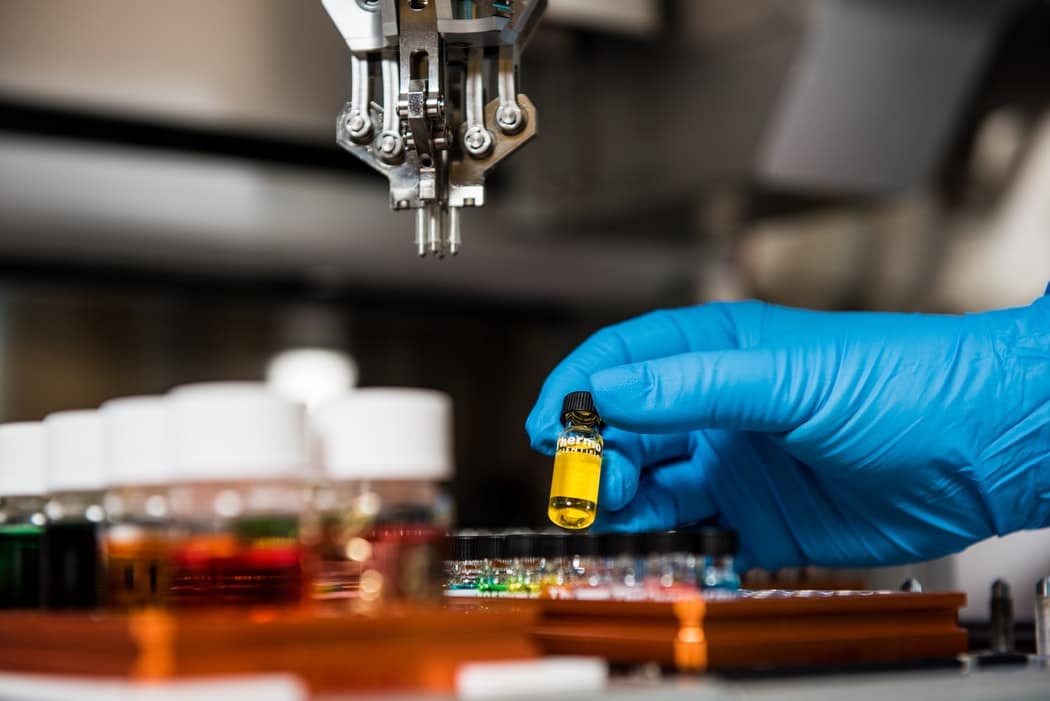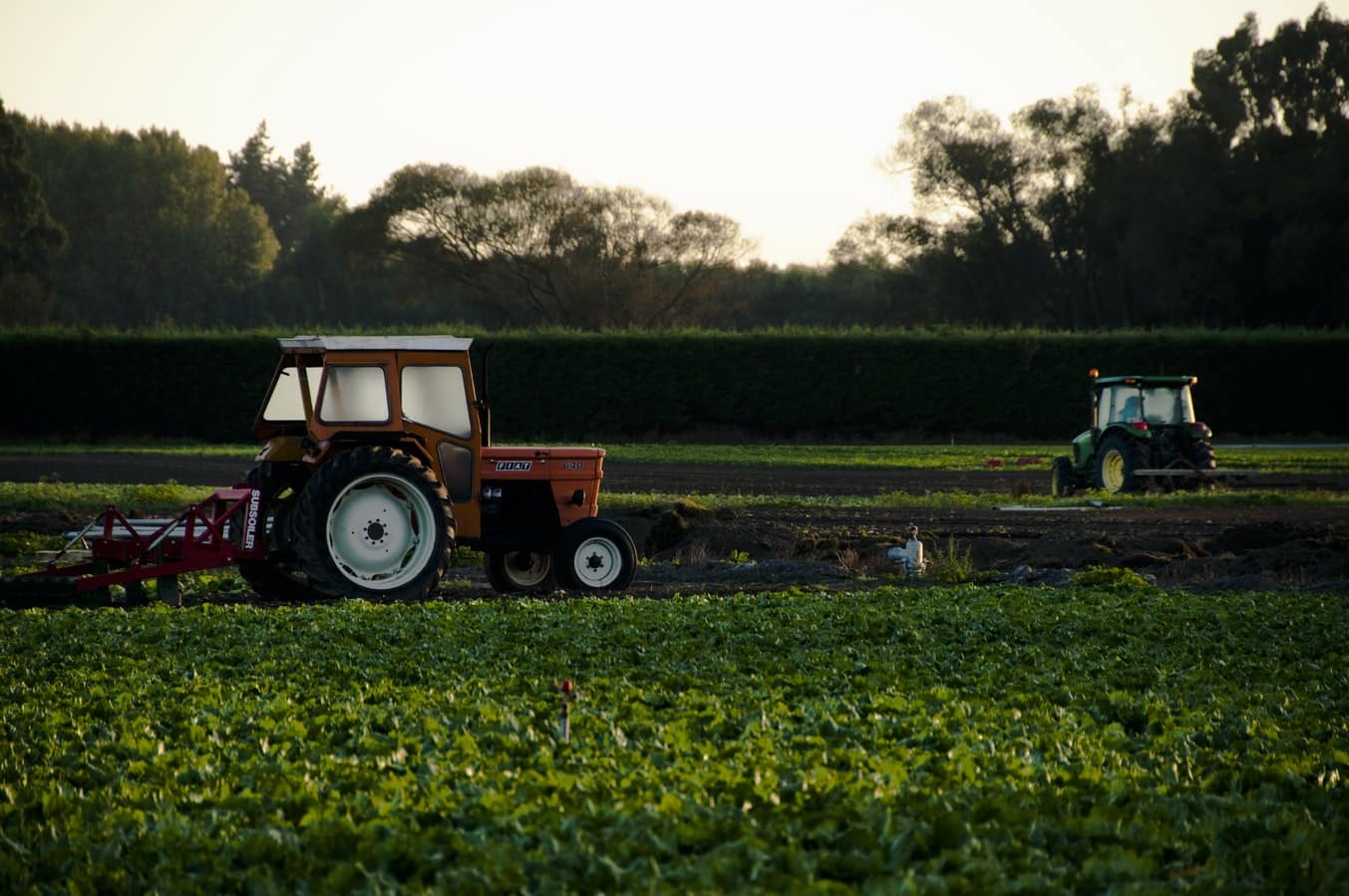Phosphor Bronze Alloy Bushing
Bearings and Bushings for the Future: Precision and Customization: Our company, in bearing engineering with decades of experience, designs and develops high-precision self-lubricating bronze bearings & plain bushes. We offer a wide array of sliding bearings tailored to meet specific needs. Renowned for our expertise in custom bronze bushing and slide plate solutions, we provide an expansive selection of bushing metal alloys. Contact us today to benefit from unparalleled services at competitive prices.
Phosphor Bronze Alloy Bushing
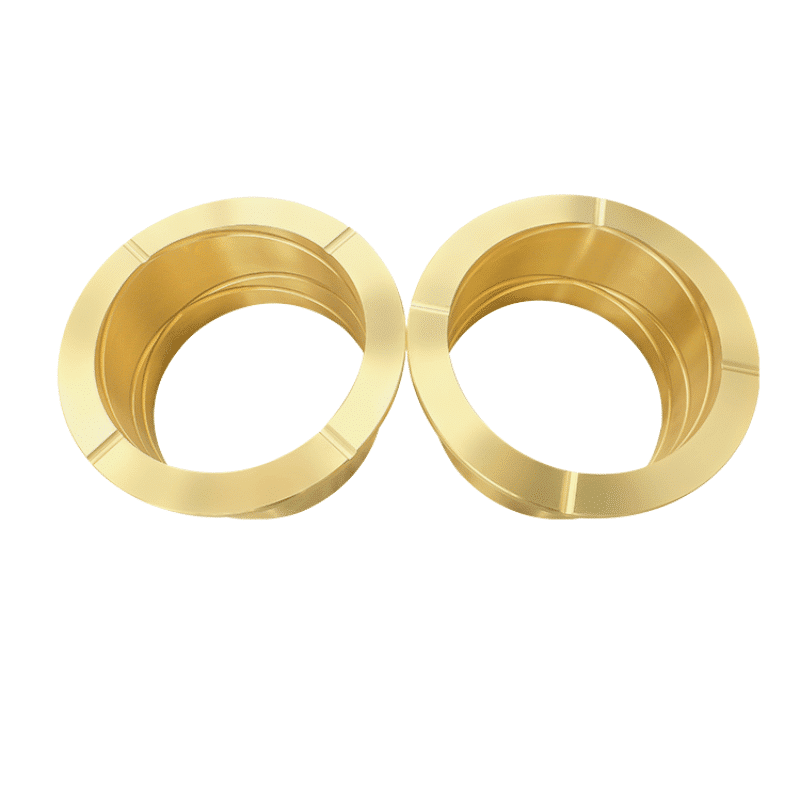
Self-Lubricating Bearings – Always Ready to Adapt to Your Business Needs
We manufacture oil-grooved bronze bushes designed for high-temperature and submerged applications where grease, oil, and plastics fail. Our non-galling, high-temperature bearings improve reliability, reduce costs, and minimize downtime. Reach out for expert engineering support. For precision and performance, trust us for your phosphor bronze bush needs.
Oil-Free Bronze Bushings with Precision CNC OEM Services from China
Beautifully crafted leather products.
China offers oil-free bushings for industrial applications, including phosphor bronze, bronze, brass, cast bronze, and sintered bronze options, with CAD downloads available. Custom sizes are available in both metric and inches.
APPLICATIONS FOR PHOSPHOR BRONZE BUSHINGS
- Maintenance and repair parts
- Power generation
- Machinery engineering
- Marine and shipbuilding
- Oil and gas
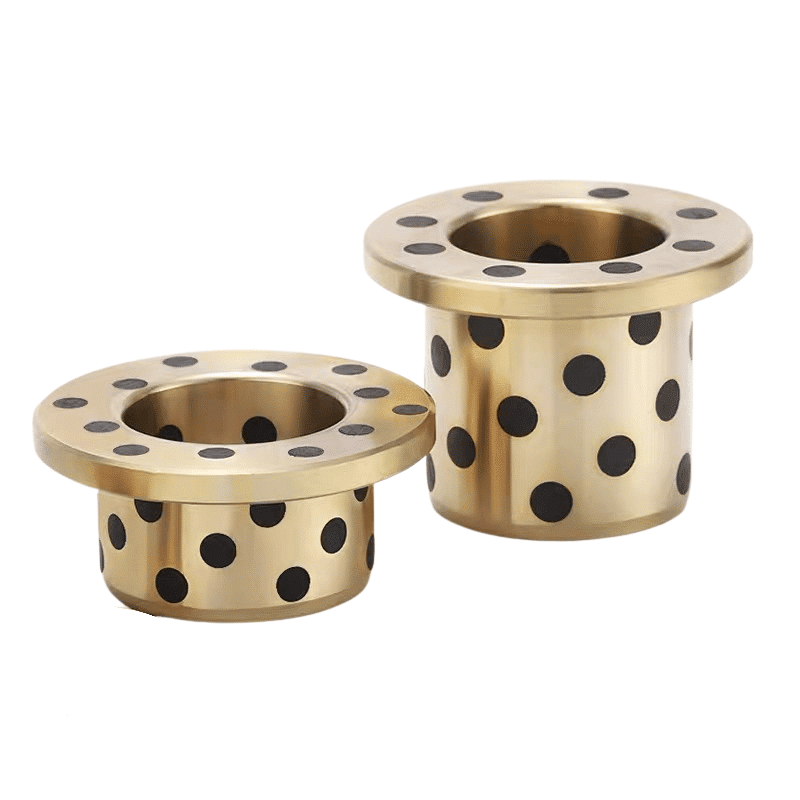
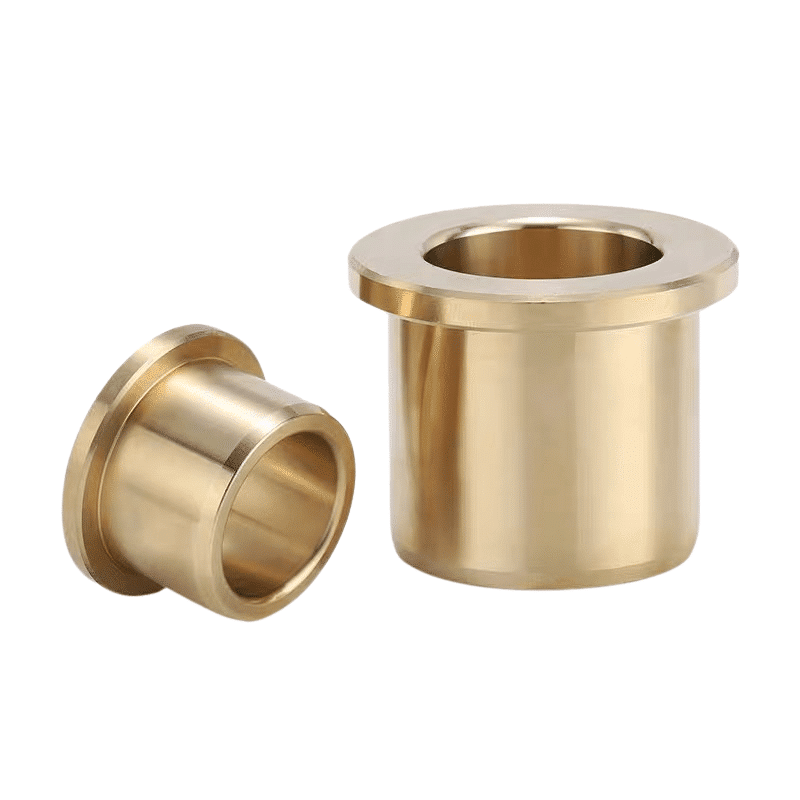
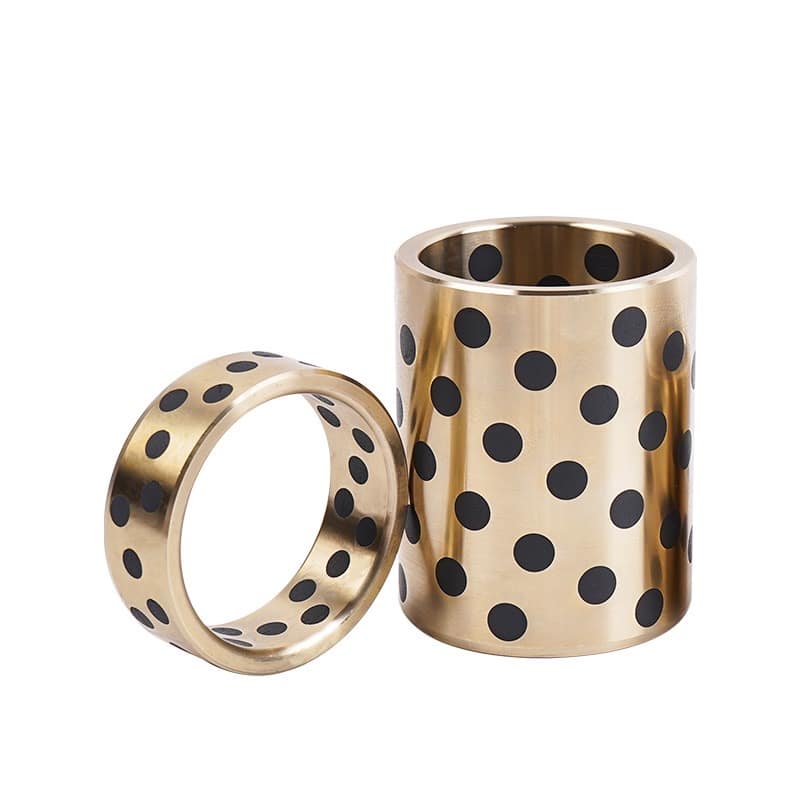
Bronze Bushing Graphite Components: Durable, Affordable Alternatives to Metal-Backed and Custom Injection-Molded Bearings.
Metal self-lubricating bearings surpass expectations by substituting solid guide units with bronze bushings, leading to significant cost reductions and no lubrication requirements. Bronze graphite bushings serve as robust guides, while cast bronze bearings manage high loads at extreme speeds. These plain bearings reduce wear, minimize downtime, and improve performance. Key benefits of bronze bushings include:
- – Reduced manufacturing costs
- – No maintenance required
- – Improved machine uptime
- – Better technical performance
- – Longer service life
- – Higher quality
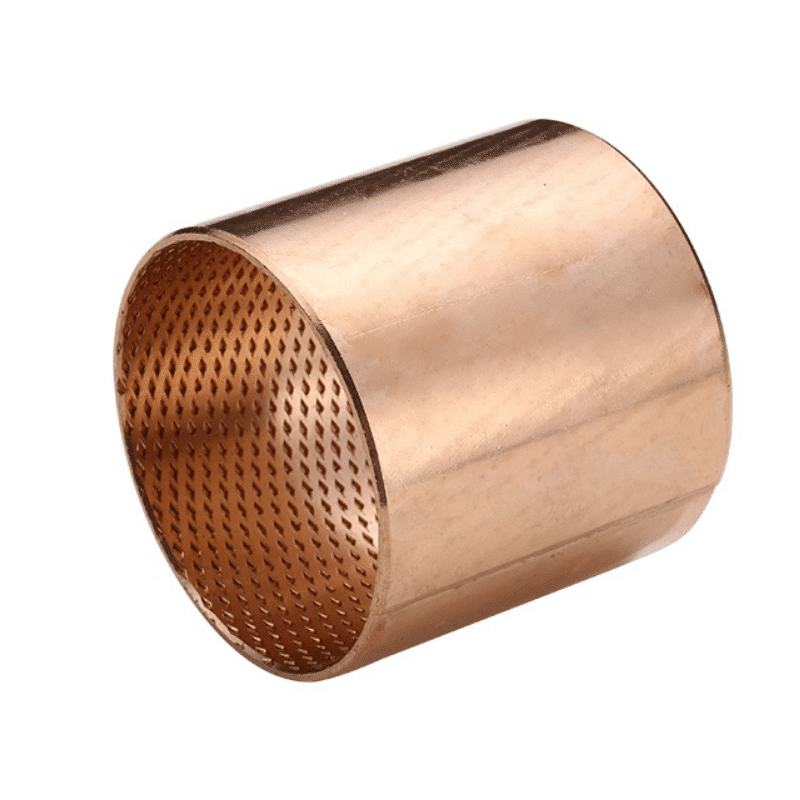
Standard Material for Bronze Bushings: Phosphor Bronze Excellence!
Design maintenance-free, dry-running bearing bushings using durable bronze alloys. Phosphor bronze bushings are highly valued for their strength, wear, and corrosion resistance, offering a cost-effective alternative to conventional bearings. They are resistant to dust and dirt, performing well under high loads and speeds in applications such as bearings, gears, and worm gears. Our selection includes phosphor bronze and aluminum bronze bushings, renowned for their excellent machinability, high strength, and durability. Contact us for a free quote on self-lubricating bushings.
Bronze Bearing, Oil & Grease Groove Bronze Bushings
Custom bronze bushings can be tailored in size and alloy, providing versatile, high-performance, and often maintenance-free solutions for various applications.
Wrapped phosphor bronze bushings
Phosphor bronze bushings, typically made from CuSn8 alloy (DIN 17662), are plain bearings recognized for their exceptional wear resistance and low friction.
Wrapped phosphor bronze alloy
Phosphor bronze (CuSn8) bushings provide a durable, maintenance-free option for applications requiring high wear resistance.
Bronze bushings, including phosphor bronze alloy bushings, are essential components in various industrial and mechanical applications due to their excellent wear resistance, low friction, and durability. Below is a comprehensive overview of the types of bronze bushings, their properties, applications, and selection criteria, with a focus on phosphor bronze alloy bushings.
Types of Bronze Bushings
- Phosphor Bronze Bushings:
- Composition: Copper, tin, and phosphorus.
- Properties: High durability, fatigue resistance, excellent corrosion resistance, and low friction coefficient.
- Applications: Electrical components, wear-resistant parts, elastic components (e.g., springs, connectors), and medium-speed, heavy-load bearings.
- Advantages: Self-lubricating, maintenance-free, and capable of operating at temperatures up to 250°C.
- Aluminum Bronze Bushings:
- Composition: Copper, aluminum, iron, and nickel.
- Properties: High strength, shock resistance, wear resistance, and corrosion resistance.
- Applications: Heavy-duty applications such as landing gear components, marine engine parts, and high-load bearings.
- Manganese Bronze Bushings:
- Composition: Copper, zinc, and manganese.
- Properties: High strength, toughness, excellent corrosion resistance, and low friction coefficient.
- Applications: High-load and high-speed applications, such as gears and heavy machinery components.
- Bearing Bronze Bushings (Tin Bronze and Leaded Tin Bronze):
- Composition: Copper, tin, and lead (in leaded tin bronze).
- Properties: Superior machining properties, moderate corrosion resistance, and good load-bearing capacity.
- Applications: Automotive bearings, pumps, cylinders, and general-purpose bearings.
- Copper Bushings:
- Composition: Pure copper or high-copper alloys.
- Properties: Excellent electrical conductivity and corrosion resistance.
- Applications: Electrical systems, water-related applications, and low-friction components.
Phosphor Bronze Bushings: Detailed Overview
Composition and Properties
- Composition: Copper (Cu), tin (Sn), and phosphorus (P).
- Key Properties:
- High hardness and wear resistance.
- Excellent fatigue resistance and elasticity.
- Low friction coefficient and self-lubricating properties.
- Superior corrosion resistance.
- Non-sparking under impact, making it safe for certain environments.
Applications
- Wear-Resistant Parts: Bushings, bearings, and sliding components.
- Elastic Components: Springs, connectors, and terminals.
- Electrical Components: Connectors, switches, and lead frames.
- High-Tech Industry: Computer and cellphone connectors, vibration sheets, and electronic switches.
Advantages in Bearing Applications
- Self-Aligning: Insensitive to shaft deflection.
- High Load Capacity: Uniform load distribution and radial load capacity.
- Maintenance-Free: Self-lubricating properties reduce the need for frequent maintenance.
- Temperature Resistance: Operates effectively at temperatures up to 250°C.
Customization and Manufacturing
- Dimensions: Available in diameters from 70 mm to 3000 mm, with a maximum weight capacity of 3000 kg.
- Material Variations: Customizable based on specific alloy requirements and manufacturing methods.
- Production Processes:
- Cold working (e.g., cold extrusion) to achieve high hardness and precision.
- Annealing to soften the material for further processing.
- Precision machining to meet exact dimensional specifications.
Choosing the Right Bronze Alloy for Bearings
When selecting a bronze alloy for bushings, consider the following factors:
- Load Capacity: Ensure the alloy can handle the expected radial and axial loads.
- Operational Speed: Choose alloys with low friction coefficients for high-speed applications.
- Temperature Range: Select materials that can withstand the operating temperature.
- Environmental Conditions: Consider corrosion resistance and compatibility with the operating environment.
- Lifespan and Maintenance: Opt for self-lubricating alloys to reduce maintenance requirements.
- Cost-Effectiveness: Balance performance with budget constraints.
Common Bearing Alloys and Their Applications
- Leaded Tin Bronze:
- Applications: Automotive bearings, pumps, and cylinders.
- Advantages: Cost-effective, good strength, and corrosion resistance. Allows for embedding debris, protecting the bearing and shaft.
- Aluminum Bronze (Nickel-Containing):
- Applications: Heavy-duty bearings and high-load components.
- Advantages: High strength and durability for demanding environments.
- Phosphor Bronze:
- Applications: Medium-speed, heavy-load bearings, and electrical components.
- Advantages: Excellent wear resistance, low friction, and self-lubricating properties.
Conclusion
Bronze bushings, particularly those made from phosphor bronze, are indispensable in a wide range of industrial and mechanical applications. Their unique combination of hardness, wear resistance, low friction, and corrosion resistance makes them ideal for demanding environments. By offering customized solutions in various alloys, dimensions, and configurations, your company provides high-performance bushings tailored to meet specific customer needs. Consulting with materials experts can further ensure the selection of the most suitable alloy for optimal performance and cost-effectiveness.
Phosphor Bronze Bush: Composition, Grades, and Machinability
Phosphor bronze is a versatile alloy that has stood the test of time, offering an outstanding balance of properties and a wealth of uses across several industries. In this article, we will delve into the structure and composition of phosphor bronze, its various grades, and its machinability, focusing particularly on its use in creating bushings.
Phosphor Bronze Composition
Phosphor bronze, an alloy of copper, tin, and phosphorous, is notable for its toughness, strength, low friction, fine grain, and excellent wear resistance. The inclusion of phosphorous in the alloy gives it increased hardness and also helps in decreasing viscosity during casting.
The standard composition of phosphor bronze includes 3.5 to 10% of tin, 0.01 to 0.35% of phosphorus, with the rest being copper. Tin increases the alloy’s corrosion resistance and strength, while phosphorous further boosts the alloy’s wear resistance and stiffness. The copper component is primarily responsible for the alloy’s excellent conductivity.
Phosphor Bronze Bush
Bushings or bushes made from phosphor bronze are highly sought after due to their remarkable mechanical properties. Phosphor bronze is commonly used in the manufacture of sleeve bearings or bushings because of its good machinability and resilience to wear and fatigue. It also has excellent resistance to chemical attacks and corrosion.
These phosphor bronze bushings are extensively utilized in various industries such as automotive, aviation, heavy machinery, marine applications, and many others. The exceptional durability, conductivity, and resistance to deformation under load make phosphor bronze bushings an ideal choice for applications subject to high stress and demanding environments.
Phosphor Bronze Grades
There are several grades of phosphor bronze, each serving different purposes and applications. The different grades essentially alter the percentages of the primary elements (copper, tin, and phosphorus) to achieve desired properties for specific applications.
Two popular grades are:
- C51000 (Grade A): This grade, also known as 5% A Phosphor Bronze, contains approximately 5% tin, 0.2% phosphorus, and the balance copper. This composition offers good electrical and thermal conductivity and is highly resistant to stress corrosion cracking. C51000 grade is often used in electrical products, fasteners, and springs.
- C54400 (Grade B): The C54400 grade, or Free Cutting Phosphor Bronze, contains approximately 4% tin, 4% zinc, 0.25% phosphorus, and the balance copper. The inclusion of zinc and lower tin content gives this grade enhanced machinability, making it ideal for intricate machining applications.
Phosphor Bronze Machinability
Phosphor bronze is generally known for its good machinability. It can be efficiently processed using various machining techniques such as turning, drilling, or milling. The material’s hardness, combined with its toughness, allows for tight tolerances and fine finishes in the final product.
Among the various grades, C54400 Phosphor Bronze is highly appreciated for its superior machinability. The alloy’s specific composition reduces tool wear, making it ideal for intricate machining operations. The grade’s machinability rating is 80, based on a 20% IZOD machinability rating for C36000 (free-cutting brass).
Nevertheless, the choice of machining technique and cutting tools should be made carefully to avoid any possible deformation or damage. Regular lubrication during machining also helps prevent overheating and enhances the tool’s lifespan.
In conclusion, the phosphor bronze alloy offers a comprehensive package of benefits – a good balance of strength, durability, corrosion resistance, and excellent machinability. Its use in bushings is an ideal testament to these properties, serving demanding applications across various industries with remarkable efficiency.
Your reliable source for bronze bushing, flanged bronze bushings!
We add considerable value to our capabilities with a range of services that enhance our portfolio and supply. From bespoke supply to laboratory services, we offer high quality bronze material of service for our customers. Click on an image below to discover more.
Your reliable source for bronze bushing . Good Service. Family-Owned Company. Fair Prices. Expert Advice. Highlights: Providing Good Service.
“Welcome to our family-owned company, your reliable source for top-quality bronze bushings, including phosphor bronze alloy bushings and flanged bronze bushings. We specialize in providing wrapped bronze solid bearing bushings and split type sleeves, crafted to exacting standards to meet your specific needs.
Our comprehensive range of services is designed to add substantial value to our product offerings. Whether you need bespoke solutions tailored to unique specifications, or advanced laboratory services to ensure optimal product performance, we’re here to serve you.
When you choose us, you’ll not only get access to high-quality bronze materials and products, but also the benefit of our exceptional service. Our expert team is committed to providing insightful advice, fair pricing, and superior service at every stage of your purchasing journey.
Browse through our gallery to learn more about our products and services. With our commitment to quality and service, we’re sure you’ll find us to be your reliable partner in sourcing bronze bushings. Contact us today for expert advice, fair pricing, and a service experience you’ll appreciate.”
Remember, the way you present your company and its offerings is crucial in attracting potential clients. Highlighting the quality of your products, the breadth of your services, and your dedication to customer service can help distinguish your company in a competitive market.
Standard Material Codes for Cast Phosphor Bronze Bearings
Bronze is especially well-suited for bushings because of its properties such as:
- Low friction: Bronze has a natural low coefficient of friction which makes it ideal for parts where metal will be rubbing against metal, reducing the likelihood of seizing or galling.
- Resistance to wear and corrosion: Bronze alloys are generally resistant to wear and corrosion, which makes them well suited for use in harsh environments and applications that involve exposure to water or corrosive chemicals.
- High load carrying capacity: Certain bronze alloys are especially strong, enabling them to withstand high loads without failing.
- Embeddability: Some bronze alloys have the ability to embed small particles of dirt or debris, which can help protect both the bushing and the shaft it rides on from damage.
- Conformability: Bronze bushings can conform to irregularities in the shaft, which can be beneficial in applications where the shaft may not be perfectly round or may not be perfectly aligned with the housing.
Phosphor bronze bearings are widely used across various industries due to their excellent properties and performance advantages. When selecting phosphor bronze bearings, it is essential to be familiar with the standard material codes that denote specific alloy compositions. These codes, established by various international organizations, help ensure consistent material properties and quality. This article lists some standard material codes for cast phosphor bronze bearings from different organizations.
- American Society for Testing and Materials (ASTM)
ASTM is an international organization that develops and publishes technical standards for materials, products, and systems. Some common ASTM material codes for cast phosphor bronze bearings are:
- ASTM B505 (C54400): This code represents a leaded phosphor bronze alloy with a nominal composition of 88.0% copper, 4.0% tin, 4.0% lead, and 0.25% phosphorus. It offers excellent machinability and wear resistance.
- ASTM B584 (C90700): This code denotes a tin-bronze alloy with a nominal composition of 89.0% copper, 11.0% tin, and 0.25% phosphorus. It is known for its high wear resistance and good corrosion resistance.
- ASTM B271 (C90800): This code represents a high-strength phosphor bronze alloy with a nominal composition of 88.5% copper, 10.0% tin, 0.5% lead, and 0.25% phosphorus. It is characterized by its high load capacity and excellent wear resistance.
- British Standards Institution (BSI)
The British Standards Institution (BSI) is the United Kingdom’s national standards body that develops and maintains technical standards for various materials and products. Some common BSI material codes for cast phosphor bronze bearings are:
- BS 1400 PB1: This code represents a leaded phosphor bronze alloy with a nominal composition of 88.8% copper, 5.0% tin, 5.0% lead, and 0.5% phosphorus. It offers good machinability and wear resistance.
- BS 1400 PB2: This code denotes a tin-bronze alloy with a nominal composition of 89.7% copper, 10.0% tin, and 0.3% phosphorus. It is known for its high wear resistance and good corrosion resistance.
- Deutsches Institut für Normung (DIN)
The Deutsches Institut für Normung (DIN) is the German national organization for standardization. Some common DIN material codes for cast phosphor bronze bearings are:
- DIN 1705 (CuSn5ZnPb): This code represents a leaded phosphor bronze alloy with a nominal composition of 84.0% copper, 5.0% tin, 5.0% lead, and 6.0% zinc. It offers good machinability and wear resistance.
- DIN 1705 (CuSn10): This code denotes a tin-bronze alloy with a nominal composition of 90.0% copper and 10.0% tin. It is known for its high wear resistance and good corrosion resistance.
Understanding the standard material codes for cast phosphor bronze bearings is crucial to ensure proper selection and application of these bearings. These codes, established by international organizations like ASTM, BSI, and DIN, provide a consistent way to describe and identify the material properties and compositions of phosphor bronze alloys, ultimately contributing to the optimal performance and efficiency of engineering systems.
Phosphor Bronze Bushings: The Future of Efficient and Sustainable Engineering
Phosphor bronze bushings have emerged as a popular and sustainable choice in engineering applications across various industries. These versatile, high-performance bushings offer a range of benefits, including reduced friction, improved wear resistance, and increased durability. As industries continue to seek innovative and eco-friendly solutions, the promotion of phosphor bronze bushings has become increasingly important. This article highlights the advantages of using phosphor bronze bushings and why they are poised to revolutionize the engineering sector.
What is Phosphor Bronze?
Phosphor bronze is a copper alloy consisting of copper, tin, and phosphorus. The addition of tin and phosphorus provides the material with improved strength, corrosion resistance, and wear resistance compared to pure copper. This makes phosphor bronze an ideal choice for manufacturing bushings, bearings, and other wear-resistant components used in various engineering applications.
Benefits of Phosphor Bronze Bushings
- Reduced Friction and Improved Wear Resistance
Phosphor bronze bushings offer excellent friction reduction and wear resistance, thanks to the presence of a thin film of tin oxides on their surface. This film acts as a lubricating layer, reducing friction between the bushing and the mating component. As a result, phosphor bronze bushings can minimize wear and extend the service life of machinery and equipment.
- High Load Capacity and Durability
Phosphor bronze bushings exhibit high load-carrying capacity, making them suitable for use in heavy-duty applications. The alloy’s inherent strength and durability ensure that the bushings maintain their shape and function under high loads and stress conditions. This translates into reduced maintenance and downtime, ultimately enhancing the efficiency of industrial operations.
- Corrosion Resistance
Phosphor bronze bushings are highly resistant to corrosion, particularly in harsh environments or when exposed to saltwater or other corrosive elements. This property makes them an ideal choice for marine applications, as well as in chemical processing plants and other industries where corrosion resistance is crucial for maintaining the integrity of equipment and components.
- Eco-friendly and Sustainable
Phosphor bronze is an environmentally friendly material, as it is both recyclable and sustainable. The use of phosphor bronze bushings helps reduce waste generation and resource consumption, contributing to greener industrial practices. Moreover, the extended service life of these bushings reduces the need for frequent replacements, further minimizing environmental impact.
- Wide Range of Applications
Phosphor bronze bushings are suitable for a wide range of applications across various industries, including automotive, aerospace, marine, power generation, and manufacturing. Their versatility and adaptability make them an excellent choice for engineers seeking to design efficient, long-lasting, and sustainable systems.
Exploring the Growing Markets for Phosphor Bronze Bushings
Phosphor bronze bushings have gained increasing popularity across various industries due to their exceptional properties, such as reduced friction, improved wear resistance, high load capacity, and corrosion resistance. As the demand for sustainable and efficient engineering solutions grows, so does the market for phosphor bronze bushings. This article explores the major markets where phosphor bronze bushings are making a significant impact and the factors driving their growth.
Automotive Industry
The automotive industry is a major market for phosphor bronze bushings. These bushings are used in various automotive components, including transmission systems, suspension systems, steering systems, and engine components. The high load capacity and wear resistance of phosphor bronze bushings make them ideal for the demanding conditions of automotive applications, contributing to improved performance, fuel efficiency, and reduced maintenance requirements.
Marine Industry
Phosphor bronze bushings are widely used in the marine industry due to their excellent corrosion resistance, particularly in saltwater environments. They are commonly found in ship propeller systems, rudder assemblies, and winches, among other marine equipment. The durability and long service life of phosphor bronze bushings contribute to reduced maintenance costs and improved operational efficiency in marine applications.
Power Generation Industry
In the power generation industry, phosphor bronze bushings are used in various components of turbines, generators, and pumps. Their high load capacity, wear resistance, and corrosion resistance make them suitable for the demanding conditions encountered in power generation systems. The extended service life and low maintenance requirements of phosphor bronze bushings contribute to the overall efficiency and reliability of power generation systems.
Manufacturing and Processing Industries
Phosphor bronze bushings are widely used in manufacturing and processing industries, including food processing, chemical processing, and textile manufacturing. They are used in various types of equipment, such as conveyors, mixers, and pumps, where their wear resistance, corrosion resistance, and high load capacity are essential for maintaining efficient operations.
Heavy Machinery and Construction
Heavy machinery and construction equipment, such as excavators, cranes, and bulldozers, rely on phosphor bronze bushings for their durability and high load-carrying capacity. The harsh operating conditions of construction sites demand components that can withstand heavy loads, wear, and corrosion, making phosphor bronze bushings an ideal choice for these applications.
The growing markets for phosphor bronze bushings are a testament to their versatility and exceptional properties. As industries continue to prioritize sustainability, efficiency, and performance, the demand for phosphor bronze bushings is expected to increase even further. By exploring and understanding these markets, manufacturers, engineers, and end-users can better appreciate the value and potential of phosphor bronze bushings in a wide range of applications.
| Property/Characteristic | Description |
|---|---|
| Material | Phosphor Bronze |
| Composition | Copper (Cu) 94.0-96.0%, Tin (Sn) 4.0-6.0%, Phosphorus (P) 0.01-0.35% |
| Density | 8.8 g/cm³ |
| Melting Point | 880-890°C (1620-1634°F) |
| Tensile Strength | 360-620 MPa |
| Yield Strength | 140-310 MPa |
| Elastic Modulus | 110-120 GPa |
| Poisson’s Ratio | 0.34-0.36 |
| Hardness | 80-140 HB |
| Wear Resistance | Excellent |
| Corrosion Resistance | Excellent |
| Self-Lubrication | Good |
| Machinability | Good |
| Thermal Conductivity | 60-90 W/mK |
| Electrical Conductivity | 9-15% IACS |
| Applications | Bearings, Bushings, Thrust Washers, Gears, Valve Seats, Electrical Contacts, Springs, Marine Hardware, Aerospace Components, Automotive Parts, Industrial Equipment |
What are Phosphor Bronze Bearings?
Phosphor bronze is a copper alloy containing copper, tin, and phosphorus. This combination of elements results in improved strength, corrosion resistance, and wear resistance compared to pure copper. Phosphor bronze bearings are made from this alloy and are used in a variety of applications, including automotive, aerospace, marine, and manufacturing.
Benefits of Phosphor Bronze Bearings
- Reduced Friction and Improved Wear Resistance
Phosphor bronze bearings offer exceptional friction reduction and wear resistance due to the formation of a thin film of tin oxides on their surface. This film acts as a lubricating layer, reducing friction between the bearing and the mating component, minimizing wear, and extending the service life of machinery and equipment.
- High Load Capacity and Durability
Phosphor bronze bearings exhibit a high load-carrying capacity, making them suitable for heavy-duty applications. The alloy’s inherent strength and durability ensure that the bearings maintain their shape and function under high loads and stress conditions. This results in decreased maintenance and downtime, ultimately enhancing the efficiency of industrial operations.
- Corrosion Resistance
Phosphor bronze bearings are highly resistant to corrosion, particularly in harsh environments or when exposed to saltwater or other corrosive elements. This property makes them an ideal choice for marine applications, as well as in chemical processing plants and other industries where corrosion resistance is crucial for maintaining the integrity of equipment and components.
- Eco-friendly and Sustainable
Phosphor bronze is an environmentally friendly material, as it is both recyclable and sustainable. The use of phosphor bronze bearings helps reduce waste generation and resource consumption, contributing to greener industrial practices. Moreover, the extended service life of these bearings reduces the need for frequent replacements, further minimizing environmental impact.
Providing technical support is essential in promoting the use of phosphor bronze bushings.
This may include assistance with material selection, design optimization, and troubleshooting.
By offering technical support, manufacturers can demonstrate their expertise and add value to their products.
Phosphor bronze is indeed a highly valued material in the manufacturing of bushings, particularly in the automotive industry, due to its exceptional mechanical and tribological properties. Below is a detailed overview of phosphor bronze bushings, their characteristics, applications, and production processes, as well as their significance in the automotive sector.
Characteristics of Phosphor Bronze Bushings
- High Hardness and Wear Resistance:
- Phosphor bronze bushings exhibit high hardness (typically HB80 after annealing, up to HB160+ after cold working), making them highly resistant to wear.
- The addition of phosphorus prevents the formation of brittle SnO₂, enhancing durability and protecting the journal.
- Low Friction Coefficient:
- The material’s low friction coefficient ensures smooth operation and reduces energy loss in moving parts.
- Impact Toughness:
- Phosphor bronze has excellent impact resistance, making it suitable for high-stress applications.
- High Allowable Specific Pressure and Limit Linear Speed:
- Capable of handling high loads and speeds, making it ideal for demanding environments.
- Corrosion Resistance:
- Resists corrosion, extending the lifespan of components in harsh conditions.
- Workability:
- Phosphor bronze (e.g., QSn6.5-0.4) has excellent cold workability, allowing for the production of high-precision components through processes like cold extrusion.
Applications in the Automotive Industry
Phosphor bronze bushings are widely used in various automotive components, including:
- Air Compressors: For smooth and efficient operation.
- Refrigerators: In compressor mechanisms.
- Internal Combustion Engines:
- Connecting rod bushings.
- Cross pin bushings.
- Piston pin bushings.
- Camshaft bushings.
- Steering and Suspension Systems:
- Guide wheel bushings.
- Guide wheel bracket bushings.
- Transmission Systems:
- Gearbox bushings.
- Other Applications:
- Sleeve bearings, thrust washers, and cam followers.
Advantages in Automotive Applications
- Extended Mechanical Life:
- The high hardness and wear resistance of phosphor bronze bushings contribute to longer service life, reducing maintenance and replacement costs.
- Improved Performance:
- Low friction and high load capacity ensure smooth operation and efficiency.
- Compatibility with High-Hardness Journals:
- When paired with journals of sufficient hardness (e.g., >HB300), phosphor bronze bushings exhibit enhanced wear resistance and durability.
- Customizability:
- Phosphor bronze can be tailored to meet specific hardness and performance requirements (e.g., HB150–200).
Production Process of Phosphor Bronze Bushings
- Material Selection:
- Phosphor bronze alloys (e.g., QSn6.5-0.4, UNS C50100–C54200) are chosen for their balance of strength, wear resistance, and machinability.
- Cold Working:
- The material undergoes cold working processes such as cold extrusion to achieve the desired hardness and dimensional accuracy.
- Cold extrusion can achieve a section reduction rate of up to 80%, resulting in a hardness of over HB160.
- Annealing:
- Annealing is performed to soften the material for further processing, achieving a hardness of around HB80.
- Machining:
- Precision machining is used to produce cylindrical parts and other geometries required for specific applications.
- Quality Control:
- Rigorous testing ensures that the bushings meet hardness, wear resistance, and dimensional specifications.
Leaded Phosphor Bronze Variants
Leaded phosphor bronzes (e.g., UNS C54400) offer additional benefits:
- Improved Machinability: The addition of lead enhances the material’s machinability, making it easier to produce complex shapes.
- Enhanced Wear Resistance: Ideal for applications requiring high wear resistance and fatigue strength.
- Applications: Commonly used in sleeve bearings, thrust washers, and cam followers.
Future Trends and Requirements
With the advancement of the automotive industry, there is an increasing demand for bushings with:
- Higher Hardness: To meet the requirements of high-stress applications.
- Improved Wear Resistance: To extend the service life of components.
- Customized Solutions: Tailored to specific performance criteria and operating conditions.
Conclusion
Phosphor bronze bushings are a cornerstone of automotive manufacturing, offering a unique combination of hardness, wear resistance, low friction, and impact toughness. Their ability to withstand high loads, speeds, and temperatures makes them indispensable in critical applications such as internal combustion engines, steering systems, and transmissions. By leveraging advanced manufacturing techniques like cold extrusion and precision machining, phosphor bronze bushings can be customized to meet the evolving demands of the automotive industry, ensuring reliability, efficiency, and longevity.
We provide high-performance phosphor bronze bushings positions you as a key supplier for automotive and industrial applications, providing solutions that enhance mechanical life and operational efficiency.
Phosphor bronze bushings are highly valued in various industries due to their exceptional mechanical and tribological properties. Below is a detailed overview of the properties, uses, and performance of phosphor bronze bushings, as well as their significance in industrial applications.
Composition of Phosphor Bronze
- Primary Alloying Elements: Tin (Sn) and phosphorus (P).
- Typical Composition:
- Tin: 2% to 8%
- Phosphorus: 0.1% to 0.4%
- Copper (Cu): Balance
Properties of Phosphor Bronze
- Mechanical Properties:
- High Hardness: Provides excellent wear resistance.
- Elasticity: Ideal for springs and elastic components.
- Fatigue Resistance: Suitable for applications involving repetitive stress.
- Tribological Properties:
- Low Friction Coefficient: Ensures smooth operation and reduces energy loss.
- Self-Lubricating: Reduces the need for frequent maintenance.
- Wear Resistance: Extends the lifespan of components.
- Corrosion Resistance:
- Resists corrosion in various environments, making it suitable for harsh conditions.
- Electrical Properties:
- Good Electrical Conductivity: Ensures efficient performance in electrical applications.
- Low Heat Generation: Prevents overheating, ensuring safety.
- Machinability:
- Excellent machinability and chip-forming properties, allowing for efficient and precise manufacturing.
Performance and Uses of Phosphor Bronze Bushings
Performance
- Corrosion Resistance: Suitable for use in corrosive environments.
- Wear Resistance: Ideal for high-wear applications.
- Non-Sparking: Safe for use in explosive or flammable environments.
- Temperature Resistance: Can operate at temperatures up to 250°C.
- Self-Aligning: Insensitive to shaft deflection, ensuring uniform load distribution.
- High Load Capacity: Capable of handling heavy loads and radial stresses.
Uses
- Industrial Applications:
- Wear-Resistant Parts: Bushings, bearings, and sliding components.
- Elastic Components: Springs, switches, and connectors.
- General Mechanical Parts: Gears, worm gears, sleeves, and vanes.
- Electrical and Electronic Devices:
- Connectors: Ensure good contact and smooth insertion.
- Lead Frames: Provide reliable electrical connections.
- Vibrating Plates and Bellows: Used in sensors and actuators.
- Fuse Clips: Ensure safety and reliability in electrical circuits.
- Musical Instruments:
- Harmonicas: Used as gong material due to its excellent acoustic properties.
Advantages in Bearing Applications
- Self-Lubricating: Reduces the need for external lubrication, lowering maintenance costs.
- Maintenance-Free: Ensures long-term performance with minimal intervention.
- High Load Capacity: Suitable for medium-speed and heavy-load bearings.
- Uniform Load Distribution: Enhances the lifespan of both the bearing and the shaft.
- Radial Load Capacity: Can handle radial stresses effectively.
Applications in Specific Industries
- Marine:
- Corrosion-Resistant Parts: Bushings and bearings in marine engines and propellers.
- Electronics:
- High-Performance Connectors: Ensure reliable signal transmission.
- Switches and Lead Frames: Used in various electronic devices.
Conclusion
Phosphor bronze bushings are indispensable in a wide range of industrial and mechanical applications due to their unique combination of hardness, wear resistance, low friction, and corrosion resistance. Their self-lubricating and maintenance-free properties make them ideal for demanding environments, ensuring long-term performance and reliability. By offering customized solutions in various alloys, dimensions, and configurations, your company provides high-performance bushings tailored to meet specific customer needs. Consulting with materials experts can further ensure the selection of the most suitable alloy for optimal performance and cost-effectiveness.
Phosphor Bronze Washers: Applications and Benefits
Washers are an essential component in many industrial and mechanical applications. They play a crucial role in distributing the load of a fastener such as a screw or nut, effectively preventing damage and ensuring a tight fit in the assembly. Among the various materials used for washers, phosphor bronze stands out due to its unique properties. Let’s delve into the world of phosphor bronze washers, understanding their applications and benefits.
What are Phosphor Bronze Washers?
Phosphor bronze washers are precision components made from phosphor bronze, a highly durable and corrosion-resistant alloy of copper with tin and phosphorous. The alloy’s superior physical and mechanical characteristics, including a low coefficient of friction, good electrical conductivity, and excellent resistance to wear and fatigue, make it an optimal choice for manufacturing washers.
These washers come in a variety of sizes and shapes, the most common being flat round washers. However, they can also be custom designed and manufactured to suit specific application requirements.
Applications of Phosphor Bronze Washers
Phosphor bronze washers have wide-ranging applications across various industries due to their excellent mechanical properties. Here are a few notable applications:
- Electrical Components: Phosphor bronze’s good electrical conductivity makes these washers an ideal choice in electrical and electronic equipment. They ensure optimal performance and longevity of the equipment by providing a secure and stable connection.
- Automotive Industry: In the automotive industry, these washers are often used in engine components, brake parts, and other mechanical assemblies where high resistance to wear and tear is required.
- Marine Applications: The marine industry highly values phosphor bronze washers due to their excellent resistance to corrosion, especially saltwater corrosion. They are commonly used in ship components, underwater fastening systems, and other marine hardware.
- Aerospace: In aerospace applications, phosphor bronze washers are used in aircraft components due to their high fatigue resistance and strength.
- Musical Instruments: Interestingly, these washers also find use in musical instruments, particularly wind and stringed instruments, where they ensure optimal tension and tuning stability.
Benefits of Phosphor Bronze Washers
Phosphor bronze washers come with a host of benefits that make them a preferred choice in many applications:
- Durability: Thanks to the inherent strength and resilience of phosphor bronze, these washers offer excellent durability, ensuring a longer lifespan even in demanding environments.
- Corrosion Resistance: Phosphor bronze’s superior resistance to corrosion, including saltwater corrosion, makes these washers suitable for use in harsh environments, extending the life of the assembly in which they are used.
- Good Conductivity: With excellent electrical and thermal conductivity, phosphor bronze washers are an ideal choice in electrical and electronic applications.
- Low Friction: The low coefficient of friction of phosphor bronze reduces wear and tear, which is especially beneficial in moving parts.
- Availability: Phosphor bronze washers are available in a wide range of sizes and can be custom manufactured to meet specific requirements. This flexibility makes them suitable for a wide variety of applications.
In conclusion, phosphor bronze washers, owing to their unique properties, play a crucial role in a variety of industrial and mechanical applications. Their durability, excellent conductivity, and resistance to corrosion ensure a secure and long-lasting fit, making them a vital component in numerous fields.
CNC Milling Service: Boost Your Business with Our Phosphor Bronze Bushes.
Our CNC Bronze Bushing Milling Service produces high-quality bushings from a premium copper alloy with 10-12% tin, offering superior ductility, corrosion resistance, wear resistance, and mechanical strength. While soldering and brazing are options, wrought grades excel under shock loads. Ideal for heavy load and high-speed applications, our precision-engineered bushings leverage advanced CNC milling technology to meet your exact specifications. Contact us to enhance your application’s performance and reliability, fostering your business growth.

Bronze Bushing Manufacturer
Industrial Bearings & Metal Components: Phosphor Bronze Bushings
Bronze bushings are prized for their durability, reliability, and low maintenance, performing effectively in various conditions due to their high-quality bronze alloys.
Flange Bearings feature an outer ring flange that ensures precise axial positioning in housings, making them ideal for high-precision applications requiring axial load support.
Phosphor Bronze Alloy Bushings, composed of copper, tin, and phosphorus, provide excellent fatigue resistance, resilience, and low friction, suitable for demanding, corrosion-resistant applications.
Pillow Block Bearings, secured in pedestal blocks for stability, are designed for supporting simple rotating shafts.
Spherical Bearings facilitate rotational motion between parts, managing high radial and moderate axial loads while accommodating angular misalignment from shaft deflection or installation errors.
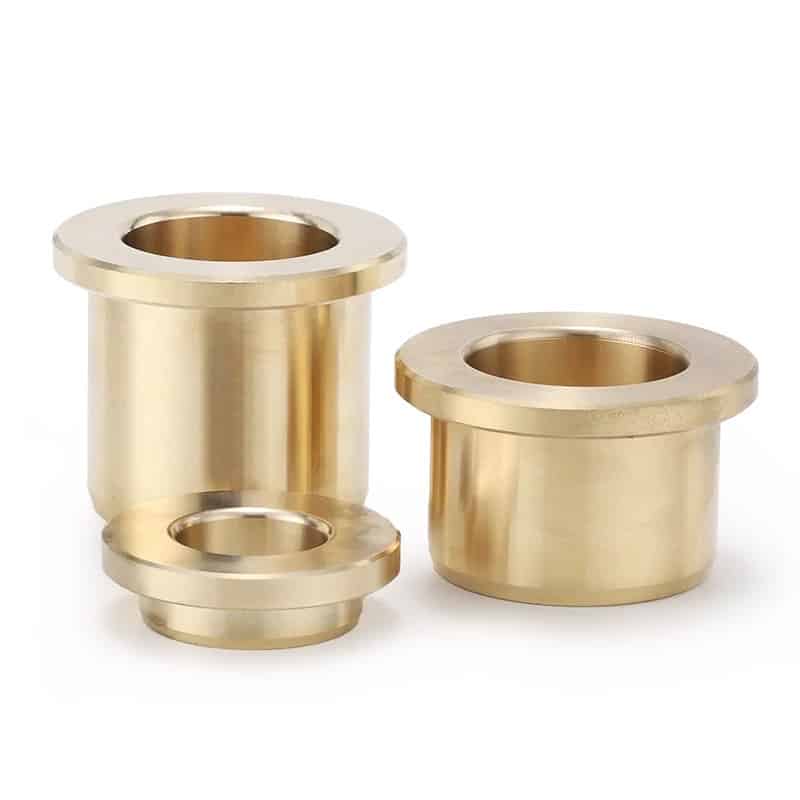
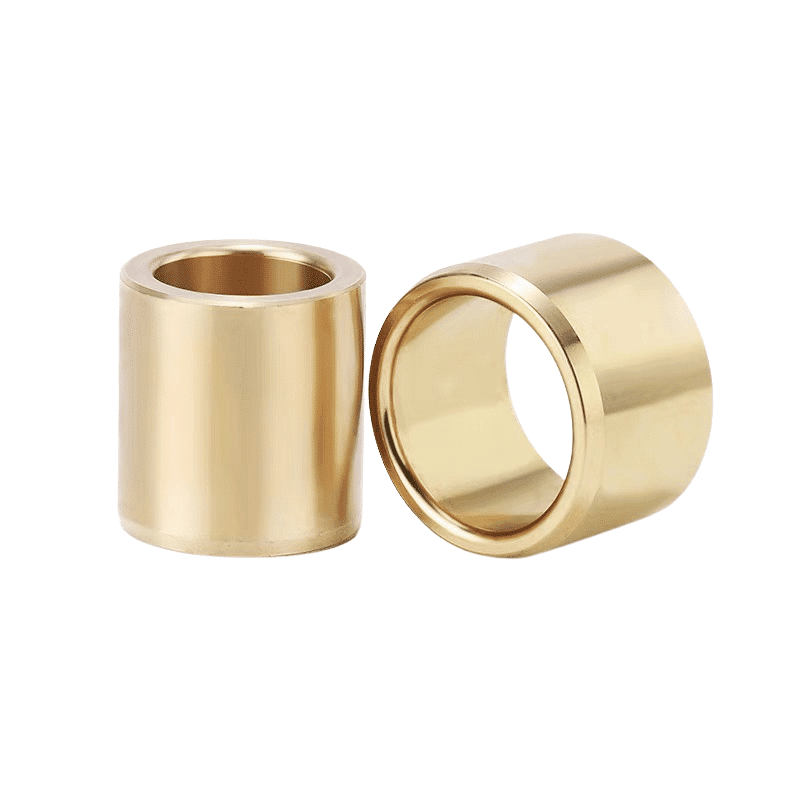
Product Quality Index
Energy Generation
Benefits of Bronze Bushing
Discover our high-strength bronze bearings and wear-resistant bushings. Enhance your research and production with our fast, reliable service. Browse our extensive range of bronze bushings and equipment today.
Bronze Bearings Key Features
Phosphor bronze is a high-strength bearing material renowned for its wear resistance, low friction, and good thermal conductivity, making it a suitable replacement for non-wear-resistant cast bearings in drilling equipment. It also resists seawater corrosion and allows for customized designs.
Metal Manufacturer – Precision Parts and Custom Bushings
CNC Grinding Service for Metal Bushing Machinability
Beautifully crafted leather products.
Our large inventory of bronze bushings and sliding bearings is ready for shipment. Trusted by manufacturers worldwide, our self-lubricating components from China feature durable bronze alloy bushings and cast bronze bearings. Engineered for minimal maintenance, our tribologically optimized metallic bushings offer superior wear, abrasion, chemical, and temperature resistance, making them suitable for diverse applications, from linear movements to high-speed rotations across multiple industries.
Durable, self-lubricating phosphorus bronze bushing.
Maintenance-Free Self-Lubricating Bushing

Solutions For Every Industry
Searching for Dependable Bushing Solutions? viiplus Has What You Need.

Design Guides, Materials
Bushing design, Comprehensive design manuals covering a range of self-lubricating materials used in all of viiplus’s manufacturing processes.

Technical Guides
Manufacturing On Demand, Technical Guides For Machining Design. Discover the latest in metal alloys, materials, and design tips for manufacturing custom machined and self-lubricating bearing parts.

Get Instant Quote
To receive your instant quote, simply upload your drawing file and choose your production process & bushing material.

Prototyping, Place Order
After you place your order, we will start the production process. You will receive updates when your order has completed production and is ready to be dispatched.

Receive Your custom Parts
We provide precision-inspected high-quality parts, packing lists and documents, and delivery tracking.

